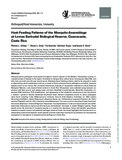Mostrar el registro sencillo del ítem
Host-Feeding Patterns of the Mosquito Assemblage at Lomas Barbudal Biological Reserve, Guanacaste, Costa Rica
| dc.creator | Gilkey, Patrick L. | |
| dc.creator | Ortiz Matos, Diana L. | |
| dc.creator | Kowalo, Tia | |
| dc.creator | Troyo Rodríguez, Adriana | |
| dc.creator | Sirot, Laura King | |
| dc.date.accessioned | 2021-08-10T16:34:41Z | |
| dc.date.available | 2021-08-10T16:34:41Z | |
| dc.date.issued | 2021-07 | |
| dc.identifier.citation | https://academic.oup.com/jme/advance-article-abstract/doi/10.1093/jme/tjab113/6315807?redirectedFrom=fulltext | |
| dc.identifier.issn | 1938-2928 | |
| dc.identifier.uri | https://hdl.handle.net/10669/84290 | |
| dc.description.abstract | Mosquito-borne pathogens have spread throughout tropical regions of the Western Hemisphere causing increased burden of disease in the region. Outbreaks of dengue fever, yellow fever, chikungunya, West Nile, and Zika have occurred over the past several years. Mosquito blood-feeding patterns need to be assayed to assist in determining which vertebrates could act as hosts of these mosquito-borne pathogens and which mosquito species could act as vectors. We conducted bloodmeal analyses of mosquitoes collected at Lomas Barbudal Biological Reserve, a dry tropical forest reserve in Costa Rica. Mosquitoes were collected using backpack aspirators and light, gravid, and resting traps, and then identified morphologically. Blood-fed mosquitoes underwent DNA extraction, PCR amplification, and sequencing of the vertebrate cytochrome b and cytochrome c oxidase 1 genes to identify vertebrate bloodmeal hosts. Several mosquitoes known to vector pathogens were found including Culex (Melanoconion) erraticus Dyar & Knab (Diptera: Culicidae), Cx. (Mel.) pedroi Sirivanakarn & Belkin, Aedes (Stegomyia) albopictus Skuse, Ae. (Ochlerotatus) scapularis Rondani, Ae. (Och.) serratus Theobald, and Ae. (Och.) taeniorhynchus Wiedemann. The most common bloodmeal hosts were basilisk lizards (Basiliscus vittatus) Wiegmann (Squamata: Corytophanidae) in Culex (Linnaeus) species and white-tailed deer (Odocoileus virginianus) Zimmermann (Artiodactyla: Cervidae) in Aedes (Meigen) species. These results show the diversity of mosquito species in a tropical dry deciduous forest and identify associations between mosquito vectors and potential pathogen reservoir hosts. Our study highlights the importance of understanding interactions between vector species and their hosts that could serve as predictors for the potential emergence or resurgence of mosquito-borne pathogens in Costa Rica. | es_ES |
| dc.description.sponsorship | Universidad de Costa Rica/[803-B9-779]/UCR/Costa Rica | es_ES |
| dc.description.sponsorship | Westminster College/[]//Estados Unidos | es_ES |
| dc.description.sponsorship | The College of Wooster/[]//Estados Unidos | es_ES |
| dc.language.iso | eng | es_ES |
| dc.source | Journal of Medical Entomology, vol.XX(X), pp.1-9 | es_ES |
| dc.subject | Mosquito-borne disease | es_ES |
| dc.subject | Ecology | es_ES |
| dc.subject | Feeding-behavior | es_ES |
| dc.subject | Molecular biology | es_ES |
| dc.subject | Tropical entomology | es_ES |
| dc.title | Host-Feeding Patterns of the Mosquito Assemblage at Lomas Barbudal Biological Reserve, Guanacaste, Costa Rica | es_ES |
| dc.type | artículo original | |
| dc.identifier.doi | 10.1093/jme/tjab113 | |
| dc.description.procedence | UCR::Vicerrectoría de Investigación::Unidades de Investigación::Ciencias de la Salud::Centro de Investigación en Enfermedades Tropicales (CIET) | es_ES |
| dc.identifier.codproyecto | 803-B9-779 |
Ficheros en el ítem
Este ítem aparece en la(s) siguiente(s) colección(ones)
-
Microbiología [1171]


